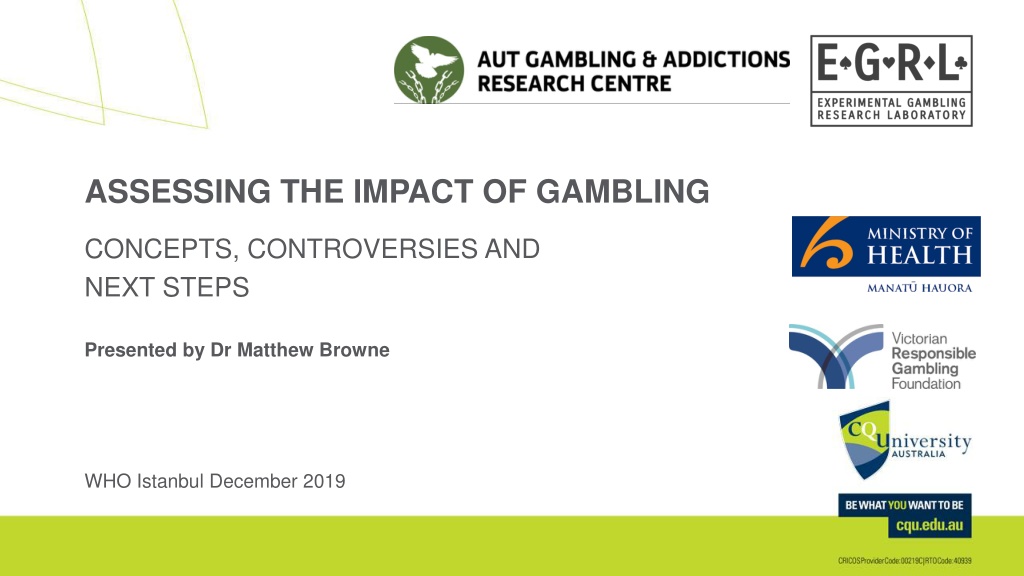Understanding the Impact of Gambling: Concepts, Controversies, and Next Steps
Dr. Matthew Browne's presentation in Istanbul in December 2019 discussed the theoretical framework, burden of harm projects in Australia and New Zealand, current work, and conclusions related to the adverse consequences of gambling on health and well-being. Focus areas included harm distribution, taxonomy of impact, challenges in assessing impact quantitatively, and direct elicitation of harm impact on quality of life.
Download Presentation

Please find below an Image/Link to download the presentation.
The content on the website is provided AS IS for your information and personal use only. It may not be sold, licensed, or shared on other websites without obtaining consent from the author. Download presentation by click this link. If you encounter any issues during the download, it is possible that the publisher has removed the file from their server.
E N D
Presentation Transcript
ASSESSING THE IMPACT OF GAMBLING CONCEPTS, CONTROVERSIES AND NEXT STEPS Presented by Dr Matthew Browne WHO Istanbul December 2019
OUTLINE 1. THEORETICAL AND CONCEPTUAL FRAMEWORK 2. BRIEF SUMMARY OF THE BURDEN OF HARM PROJECTS IN AUSTRALIA AND NEW ZEALAND 3. LIMITATIONS, IMPLICATIONS, CONTROVERSIES 4. CURRENT WORK AND CONCLUSIONS
A BASIC THEORETICAL MODEL OF HARM(S) adverse consequence due to an engagement with gambling that leads to a decrement to health or wellbeing
A BASIC THEORETICAL MODEL OF HARM(S) CAUSAL MECHANISM OUTCOME RISK FACTOR SYMPTOMATOLOGY
DISTRIBUTION OF HARM IN THE POPULATION CONTINUOUS CONTINUOUS
CHALLENGES & OBJECTIVES Treating impact as a liquid quantity (health utility), rather than classifying qualitative differences (e.g. PG prevalence) Assessing impact on the continuum of gambling problems o Not just for pathological gamblers Full epi. model of incidence, recovery, relapse, not available Dedicated measures of gambling harm Health state utilities Attributing causation
A SIMPLE APPROACH TO TAKE INTO ACCOUNT SEVERITY AND PREVALENCE Prevalence Gambling State (%) Disability Weight of Health State YLD1 = Population Direct elicitation PGSI
DIRECT ELICITATION OF IMPACT TO QOL Survey harms associated with each degree of condition severity Present experts and community members with vignettes describing those harms Elicit DW via TTO and other methods Average with respect to PGSI (Victoria, Australia) Harm by sample type and PGSI category
RESULTS: A MEASURE OF THE SEVERITY OF THE CONDITION New Zealand Harm utilities for gambling harm compared to other health states
New Zealand RESULTS: A MEASURE OF AGGREGATE POPULATION IMPACT Annual prevalence of gambling problems (by PGSI category) and other health states in the New Zealand
LIMITATIONS Though strongly data-driven, these methods rely on: o Respondents to correctly attribute the nominated harms to gambling (causality) o Experts and community to correctly assess the impact on QoL o A health utility framework for elicitation and aggregation of utility
THE MOST CONTROVERSIAL IMPLICATION That health and wellbeing impact extends beyond pathological gamblers Victoria, Australia New Zealand
TRIANGULATION (1) Population Prevalence of symptomatology (no utility elicitation)
TRIANGULATION (2) Decrements to self-reported wellbeing, controlling for covariates
RESEARCH IN PROGRESS Strong industry-sponsored pushback against quantifying impact Australian project for indirect elicitation of HUW via the SF-6D o No assumption of correct attribution by participants Case-control matching, weighting and statistical control for all relevant covariates (age, SES, etc) o water-tight evidence for the counterfactual and causality Exciting potential for analysis of bank transaction (big) data o More triangulation o The opportunity costs of excessive gambling spending o Health, financial insecurity, etc
CONCLUSIONS How we measure gambling impact influences both theory and policy The status-quo o Conflation of clinical criteria for pathology, with impact of financial losses o Implicit assumption of harm only to those with mental disorder ( at risk ) o Downplays the intrinsic risk associated with products o Qualitative, categorical thinking Where we need to be o Robust quantification of the impact accruing to different segments of society o Counting the cost of gambling, and rational weighting against public revenue o Precise and unambiguous measurement of the contribution of different products o Adopting a clear-eyed view of the mechanism unsustainable financial losses

































